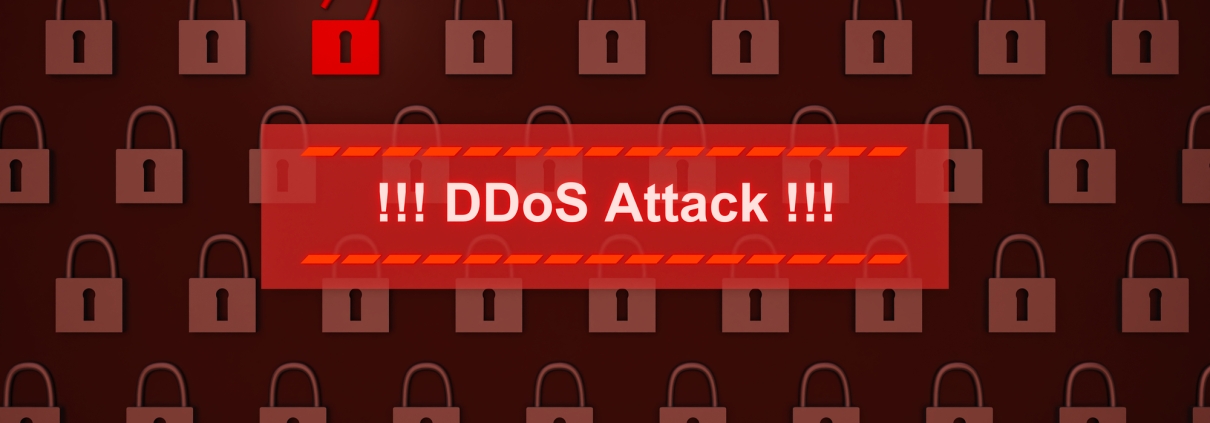What is a Distributed Denial-of-Service (DDoS) Attack?
01 September 2023A DDoS (Distributed Denial of Service) attack hinders the operations of servers, services or networks. This is done by flooding them with unwanted online traffic. In extreme scenarios, these attacks can temporarily disable a website or entire network.
DDoS attacks work by directing malicious traffic towards a target through various computers or devices. These devices typically constitute a botnet: a group of devices compromised by malware, overseen by a single attacker. Some DDoS attacks may use multiple attackers or DDoS attack tools, such as stress-testing software (e.g. LOIC) or low-and-slow programs (e.g. Slowloris).
Given their relative ease, these attacks are very common and increasing. They have the ability to cause major disruptions without needing to breach internal networks, and they can be done relatively inexpensively and without needing sophisticated tools.
Using attack surface minimization, detecting threats in real-time, and continuous DDoS mitigation, attacks can be thwarted before they make an impact on your valuable infrastructure and systems.
Why Do DDoS Attacks Happen? Who Do They Target?
Cyberattacks don’t just target big corporations and governments. They can happen to small businesses as well. Some of the reasons:
- Competition: When a competitor’s website is taken down, traffic naturally diverts. Additionally, sabotage can damage a competitor’s reputation. DDoS attacks can be outsourced cheaply to hackers in the shadier corners of the internet, and are employed by unscrupulous businesses.
- Activism: DDoS attacks are not exclusively aimed at stealing data. They are often used as a platform for activism. DDoS attacks are often employed to generate attention for protests, with targets ranging from politics to businesses and banks.
- Geopolitics: DDoS attacks are frequently used in conflicts between countries or governments. The targets of DDoS attacks are often governmental websites, especially older ones. While these attacks can be orchestrated by politically neutral hackers, governments and political parties frequently use DDoS methods to attack each other.
- Retribution: One of the most common motives for DDoS attacks is revenge. These attacks can be directed at individuals, businesses, and governments. A frequent target of DDoS attacks is former employers.
- Prelude to a Larger Threat: Amazon thwarted the largest-ever DDoS attack in 2020, peaking at 2.3 Tbps. Prior to this, the largest recorded DDoS attack happened in March 2018 which reached 1.7 Tbps. In some instances, such attacks serve as a preliminary action to a larger-scale attack or as a diversion for a more severe security breach.
- No Apparent Reason: Lastly, DDoS or DoS attacks don’t always come with a discernible reason. There are instances where hackers derive a thrill from breaching a system or a website, irrespective of their size.
The risk here highlights the ongoing responsibility of a company’s CIO/CTO to ensure the implementation of appropriate security measures. The unpredictable nature of attacks means it is necessary to maintain vigilance.
Types of DDoS Attacks
To protect against DDoS attacks, it’s vital to understand them. Three primary categories define the methodology of DDoS:
- Layer 7 DDoS attacks, or application-layer attacks: These attacks induce denial of service by flooding the victim’s server and network resources with seemingly legitimate HTTP requests. These are nuanced, targeting specific application functions or components with the intent to disrupt services.
- State-exhaustion attacks, or protocol attacks: These saturate network equipment and infrastructure by deploying layer 3 or 4 protocols (e.g. ICMP) to bombard their victim with unnecessary traffic. They exploit weaknesses in network protocols to cause a denial of service through resource exhaustion.
- Volumetric attacks: monopolize all of the victim’s bandwidth by using amplification techniques. These can be deployment of a botnet, or exploiting common network protocols. They inundate a target with more traffic than its servers can handle, leading to incapacitation.
The Impact of DDoS Attacks
A DDoS attack has the capacity to inflict significant harm, both operationally and financially. Disrupting service availability can erode customer trust, imperil revenues, and damage a brand in a matter of hours.
This was the case in the 2016 DDoS attack on DNS provider Dyn, that resulted in cascading outages for Twitter, Netflix, and Spotify. This affected millions of users, and a significant proportion of internet traffic.
How to Protect Against DDoS Attacks
Guarding against DDoS assaults can be difficult. Especially during periods of heavy traffic or across an expansive and distributed network architecture. Real prevention of DDoS threats requires several crucial measures: attack surface minimization, threat surveillance, and scalable DDoS mitigation tools.
Strategies for DDoS Defense
- Attack surface reduction: By restricting traffic to specific regions, applying a load balancer. Block outdated or unused ports, protocols, and applications. Reduce your attack surface exposure, and decrease potential impact of a DDoS attack.
- Anycast network diffusion: An Anycast network can escalate the surface area of a company’s network, making it easier to handle volumetric traffic increases. This also avoids breakdowns, by spreading traffic across multiple distributed servers.
- Adaptive, real-time threat surveillance: Keep tabs on log data to identify potential dangers. Examine network traffic patterns, and watch for traffic surges or other unusual activity. Adapt to protect against anomalous or harmful requests, protocols, and IP blocks.
- Caching: By storing requested content copies, a cache reduces the number of requests serviced by origin servers. Employ a CDN (Content Delivery Network) to cache resources. CDNs alleviate the load on a company’s servers, making it harder for both legitimate and harmful requests to overload them.
- Rate limiting: By restricting the volume of network traffic over a certain period, rate limiting effectively stops web servers from being overwhelmed by requests from specific IP addresses. Rate limiting helps prevent DDoS attacks that use botnets to spam an endpoint with an abnormal number of simultaneous requests.
Tools for preventing DDoS attacks
- Web Application Firewall (WAF): A WAF can help fend off attacks by using adjustable policies to filter, inspect, and block harmful HTTP traffic between web applications and the Internet. A WAF allows companies to implement a positive and negative security model that controls incoming traffic from specific locations and IP addresses.
- Continuous DDoS mitigation: A provider of DDoS mitigation services can assist in preventing DDoS attacks by perennially analysing network traffic, implementing policy alterations in response to emerging attack patterns, and offering a wide and dependable network of data centres. When evaluating DDoS mitigation services based in the cloud, look for a provider that gives adaptive, scalable, and continuous threat protection against complex volumetric attacks.
The Best Defense is Preparation
The defense against DDoS attacks is preparation. Employ solid network architecture, DDoS mitigation hardware or services, and incident response plans. You never knew when one might happen.
Firewalls, particularly next-generation firewalls, make great gatekeepers. They distinguish between benign user traffic and anomalies. Additionally, traffic analysis tools are invaluable. These will recognize and filter out malicious traffic before it reaches critical servers.
Finally, there’s strength in numbers. By leveraging the power of the cloud, you can gatekeep traffic before it reaches a data center. This is known as cloud-based scrubbing; a process where malicious traffic is siphoned off, leaving system resources untouched.
A proactive DDoS defense strategy is the product of hard-earned experience. For example, consider the preventative measures taken by the United States Computer Emergency Readiness Team (US-CERT) in response to the Mirai botnet DDoS attacks in 2016. Employ the best practices – such as monitoring network traffic for abnormal patterns – and use traditional network security devices like intrusion detection to prevent DDoS attacks.
Always Stay Vigilanant
Hackers are creative, and use strategies as technology evolves. IT security professionals must maintain agile defense. Perform regular audits, stringent access controls, and consistent staff training to ensure that your enterprise remains protected.
To conclude, the effort to safeguard against DDoS attacks is perpetual. Each new encounter with potential threats offers an opportunity for learning. Stay informed, adaptable, and resolute.


 2024
2024